Find out the fascinating origin of bees in America and their vital role in our ecosystem.
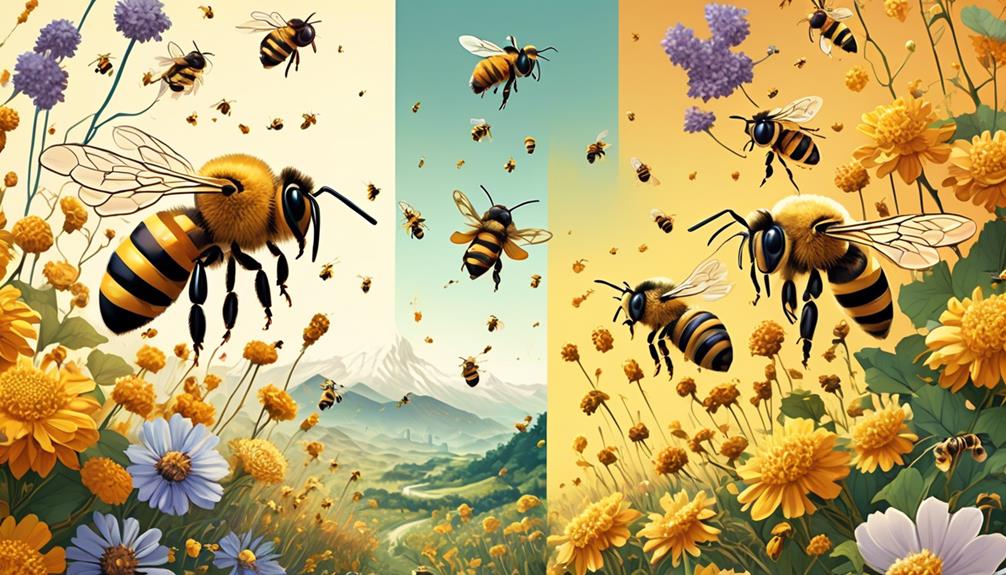
Are Bees From America?
You might not be aware that honeybees, those industrious little creatures we often associate with our gardens, were not originally native to America. In fact, it's believed they were brought over by early European settlers in the 1600s for honey production.
Yet, over time, they've become integral to our ecosystems, even being dubbed 'the pillars of agriculture'. But what about the many other types of bees buzzing in our backyards – are they American natives or foreign transplants too?
The answer to that question may surprise you – and it's certainly worth exploring further.
Key Takeaways
- Bees evolved from wasps during the Cretaceous period, approximately 130 million years ago.
- There are over 4,000 bee species in America, including the Western Honeybee, Bumblebee, Carpenter Bee, Sweat Bee, and Leafcutter Bee.
- Native bees, such as the Blue Orchard Bee and Green Sweat Bee, have evolved with local ecosystems, while imported bees, like the European Honeybee, have been introduced for agricultural purposes.
- Bees play a crucial role in American ecosystems by pollinating plants, maintaining biodiversity, and contributing to agriculture and food supply.
The Origin of Bees: A Historical Perspective
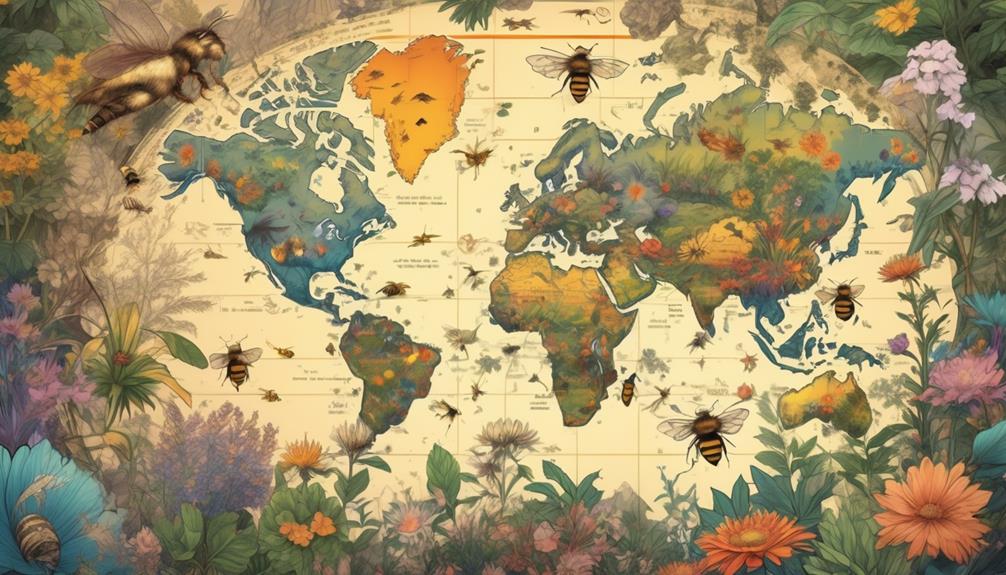
Diving into the annals of entomological history, you'll find that bees, an integral part of our ecosystem, have their origins dating back to the Cretaceous period, approximately 130 million years ago. During this prehistoric era, the first bees, ancestors of today's honeybees, evolved from wasps. Their primary food source shifted from other insects to the abundant flowering plants, resulting in a new dietary preference for nectar and pollen.
Fossil records indicate that these ancient bees were solitary creatures, different from the highly social colonies we're familiar with today. The first evidence of social behavior in bees didn't appear until the Eocene epoch, about 45 million years ago. Around this time, the first eusocial bees, with structured colonies and a division of labor, likely started to emerge.
Contrary to common belief, bees didn't originate in North America. The oldest bee fossil, named Melittosphex burmensis, was discovered in Myanmar, indicating that bees likely evolved in the Old World before spreading across the globe. So, while bees are found worldwide today, their roots are deep in the soil of a time and place far removed from modern America.
Types of American Bees
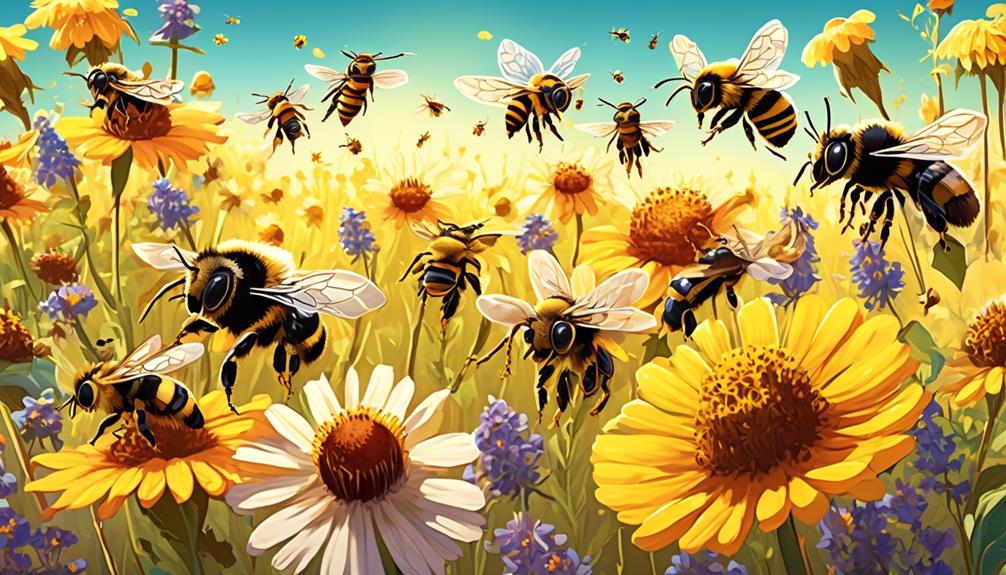
Despite their foreign origins, there's a wide variety of bee species that have made America their home, each with unique characteristics and roles in our ecosystem. You'll find over 4,000 species across the continent, all of which contribute to the pollination of plants, a critically important ecological function.
One common species you might encounter is the Western Honeybee. Known for their honey production, they're not native but have adapted well since their introduction by European settlers.
Another familiar face is the Bumblebee, a large, fuzzy insect known for their buzzing flight and ability to pollinate plants that other bees can't.
You mightn't be as familiar with the Carpenter Bee, a solitary species that burrows into wood to nest. Or the Sweat Bee, a tiny insect attracted to human sweat, but don't worry, their sting is quite mild.
Lastly, there's the Leafcutter Bee, which, as you might guess, cuts leaves to line its nest.
These are only a handful of the diverse bee species in America. Understanding them helps you appreciate the complexity of our ecosystem and the critical role bees play within it.
Native Bees Versus Imported Bees
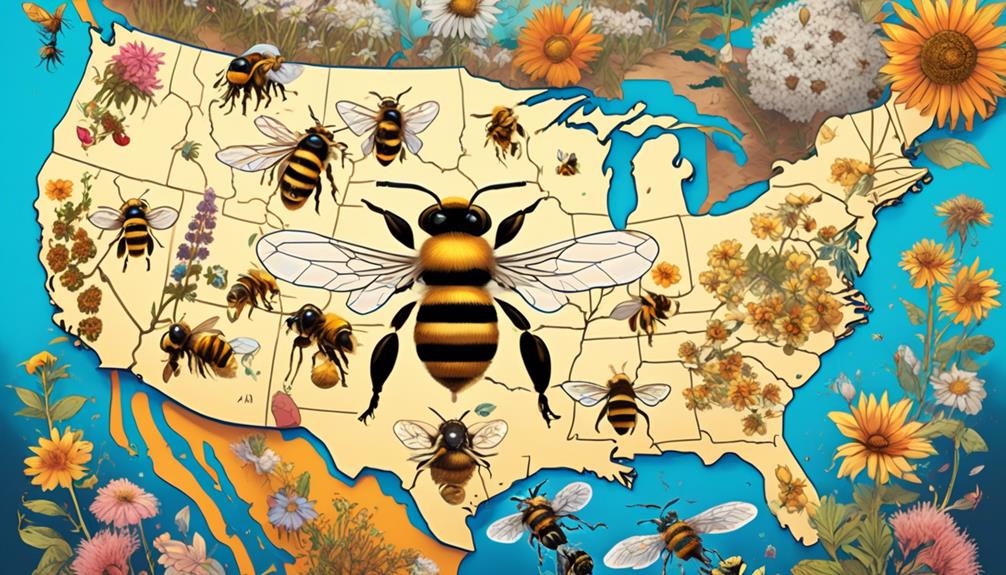
While you're familiar with the diverse range of bees now thriving in America, it's crucial to distinguish between those native to this land and those introduced from other parts of the world. More than 4,000 bee species are native, including the Blue Orchard Bee and the Green Sweat Bee. They've evolved with local ecosystems, perfectly adapted to pollinate native plants.
On the other hand, several bee species have been imported for agricultural purposes such as the European Honeybee. Although beneficial for honey production and crop pollination, these imports can sometimes outcompete native bees for resources or spread diseases.
Reflect on this comparison:
Native Bees | Imported Bees | |
|---|---|---|
Role | Specialized in pollinating native plants | Generalists, often used for crop pollination |
Impact on Ecosystem | Vital to local ecosystems' health | Can outcompete natives, spread diseases |
Example Species | Blue Orchard Bee, Green Sweat Bee | European Honeybee |
Understanding this differentiation can inspire you to help preserve our native bees. Their survival is not just a matter of biodiversity, but also a key factor in the health of our ecosystems.
The Role of Bees in American Ecosystems
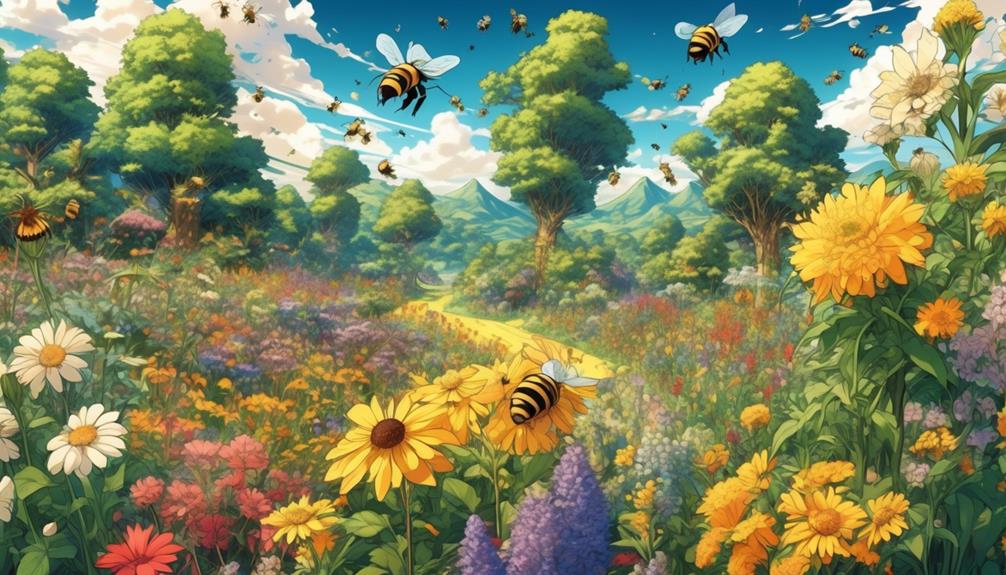
In understanding the role bees play in American ecosystems, it's essential to delve into their functions as pollinators and the interdependence they share with the local flora and fauna. As pollinators, bees carry pollen from the male parts of a flower to the female parts, enabling fertilization and the subsequent production of fruits and seeds. This process is vital for the reproduction of many plant species.
Bees' role as key pollinators means they're integral to maintaining biodiversity within American ecosystems. Many plants, including those that provide food for other wildlife, rely on bees for pollination. Without bees, these plants wouldn't produce the fruits and seeds that feed various fauna, disrupting the entire food chain.
The interaction between bees and plants is a mutualistic relationship. Bees feed on nectar and pollen, gaining nutrition, while plants get pollinated, aiding reproduction. But bees don't just pollinate wild plants. They're also crucial for pollinating crops, contributing to agriculture and food supply.
Threats to American Bee Populations
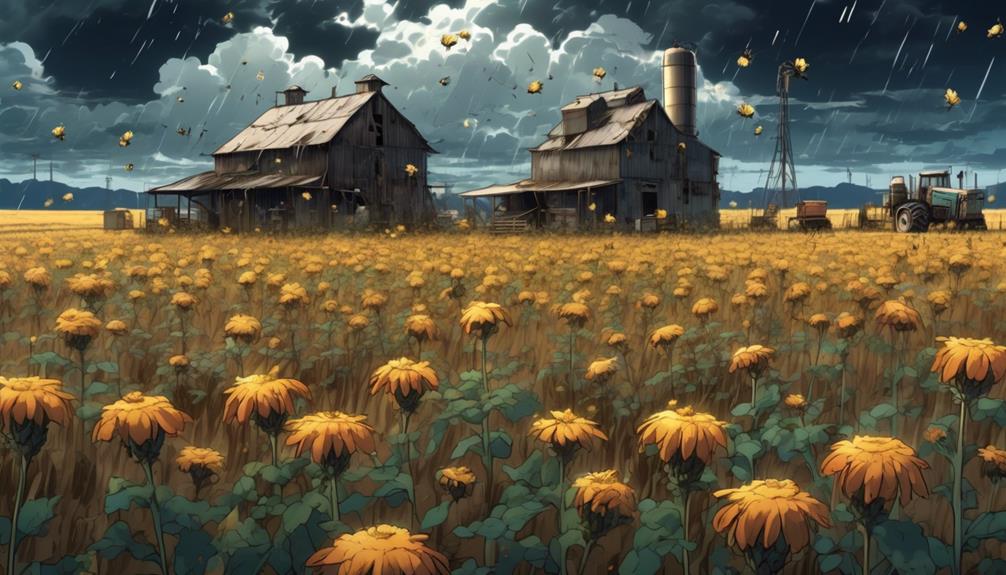
As we delve into the threats facing American bee populations, it's crucial to understand that these insects are under siege from a variety of factors. These include habitat loss, pesticides, disease, and climate change.
Habitat loss occurs when land development destroys the flowers that bees depend on for food. Without this vital source of nourishment, bee populations can dwindle rapidly.
You also have pesticides, particularly neonicotinoids, that are lethal to bees. These chemicals are absorbed by the plant, contaminating nectar and pollen, which bees then consume, leading to their death.
Next, we've got diseases like Colony Collapse Disorder (CCD) that decimate entire hives. CCD is a phenomenon where most worker bees in a colony disappear, leaving behind a queen with few nurse bees to care for remaining immature bees and the queen.
Lastly, climate change alters flowering times, which can lead to a mismatch between when flowers bloom and when bees are active. This disrupts the critical process of pollination.
It's clear that the threats are diverse and interconnected, demanding comprehensive strategies for the conservation of these essential pollinators.
Conservation Efforts for American Bees
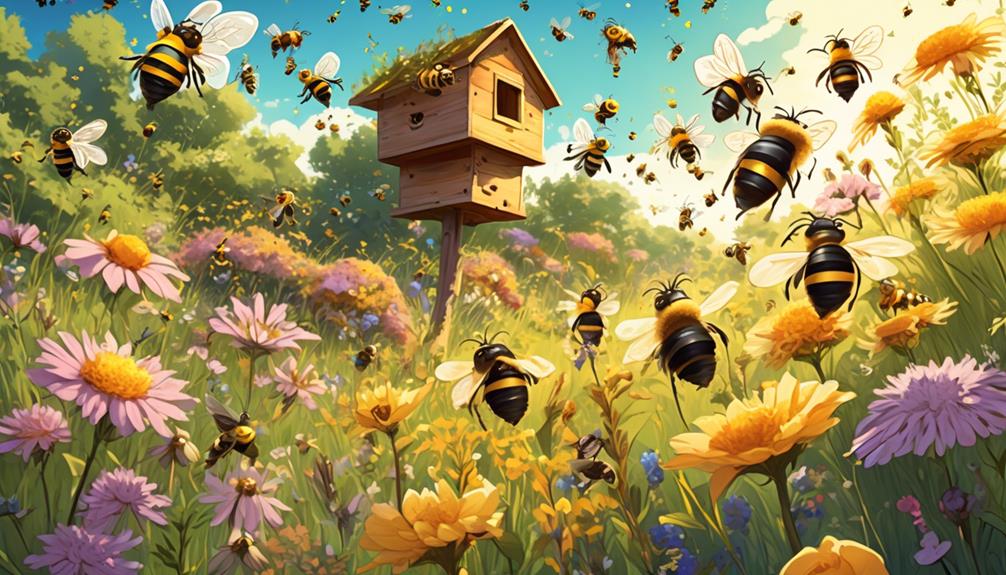
Given these numerous threats to American bee populations, it's paramount that you understand the conservation efforts underway to safeguard these essential pollinators.
One significant strategy is habitat restoration. You'll find that groups like the Xerces Society are actively restoring and protecting habitats that are crucial for bees. They're planting native wildflowers, managing landscapes, and encouraging natural ecosystems that promote bee health.
Another important focus is on pesticide reduction. Many organizations are lobbying for stricter regulations on harmful pesticides and promoting pesticide-free gardening practices. You can contribute to this effort by choosing organic produce, which supports farmers who avoid pesticide use.
Research and monitoring are also key. Entities like the Bee Informed Partnership are gathering data on bee health to better understand the threats they face. They're also developing strategies to combat diseases and parasites that plague bee populations.
Lastly, there's beekeeping. Local beekeepers play a crucial role in conservation, maintaining bee populations and educating the public on their importance. By supporting local honey production, you're indirectly contributing to bee conservation.
Frequently Asked Questions
What Are the Major Differences Between American Bees and European Bees?
You're asking about the key differences between American and European bees.
Well, American bees, specifically the American Bumblebee, are more robust and have longer tongues compared to European bees. They're also more adapted to colder climates.
On the other hand, European bees, like the European Honey Bee, are typically smaller and have shorter tongues. They're known for their honey production and are commonly used in beekeeping.
Can Bees From America Survive in Other Continents?
Yes, you'll find American bees can survive in other continents. They've successfully been introduced to places like Europe and Australia. However, it's not just about survival. They must also compete with native species, resist local pests, diseases, and adapt to different climates.
What Is the Economic Value of Beekeeping in America?
Beekeeping's economic value in America is substantial. You'll find bees pollinate crops, boosting agricultural productivity. They're vital for many fruits, vegetables, and nuts you consume daily.
Besides, honey and beeswax products contribute significantly to the economy. Additionally, beekeeping provides numerous jobs. So, you see, the economic value isn't just about honey production; it's about the wider agricultural industry and job market.
Beekeeping's impact is truly far-reaching.
How Do Seasonal Changes Affect the Behavior of American Bees?
Seasonal changes greatly influence American bees' behavior.
In spring and summer, you'll see them buzzing around, collecting nectar and pollen. They're in hive-building and reproduction mode.
However, as fall approaches, they'll start to slow down, prepare for winter, and cluster together for warmth.
In winter, they're less active, focusing on surviving the cold.
Are There Any Specific Laws in America That Protect Bees and Their Habitats?
Yes, there are specific laws in the U.S. aimed at protecting bees and their habitats.
The Endangered Species Act, for instance, lists several bee species as endangered, providing them with legal protections.
In addition, some states have legislation to maintain and protect bee habitats.
You'll find that these laws are crucial to the survival of bees, considering their key role in pollination and the maintenance of our ecosystem.
Conclusion
So, you've learned that not all bees are native to America, yet they play a crucial role in our ecosystems. Imported bees have found a home here, contributing to biodiversity.
However, threats like habitat loss, pesticides, and climate change are pushing our buzzing friends to the brink. It's up to us to champion conservation efforts, ensuring these industrious creatures continue to thrive.
Remember, every bee—native or not—adds to the rich tapestry of American wildlife.



